hen I started writing my first novel, I spent more time daydreaming than writing. I’d like to say I dreamt of character arc and plot pacing; but in reality, I spent hours envisioning the day when I would answer the door to find the FedEx guy standing over a big box. I imagined peeling off the packing tape and lifting up the flap to expose the fruits of my labor—printed copies of my novel. I’ll confess that sometimes I could even conjure the scent of new ink and paper—the smell of success!
In those early dreams, my first phone call (after the one to my mom) would be to my editor. Despite the whole novel-as-baby metaphor, I never saw my editor as a doula. She would be the close friend rushing in after the delivery, when I’d done all I could on my own to produce a beautiful baby. She’d hold my baby in her arms and coo over it, while at the same time comforting me that there were tiny bows to tame that newborn cowlick, a salve for infant acne, and as for the cradle cap—we’d tackle that together. In my fantasies, the two were directly linked: Find a great editor; sign boxes of books.
But last fall, at the Highlights Whole Novel Retreat in Pennsylvania, my definition of success shifted. After the second day of conferring, conferencing, and revising, my fellow attendees and I sat down to appetizers and informal conversation. Our mentor for the week, editor Stephen Roxburgh, told us he’d brought some toys for us to play with. He pulled a couple of Kindles and an iPad out of his bag. It felt traitorous—a bunch of writers reading and not one paper and ink book in the room. But as Stephen fielded our questions about e-books and e-readers, I began to see success didn’t have to arrive on my doorstep in a FedEx box. It could be as simple as clicking “download.”
Back home, I discussed the possibilities for e-publishing with writer friends. Many shared the same success-in-a-FedEx-box dreams. We were pen and paper people. We liked to send snail mail queries and get snail mail rejections. Although a few of us had graduated to e-queries (and the subsequent e-rejections), it was hard to envision what the whole e-publishing process would look like, let alone what a writer could hope to gain from the change in formats.
Stephen Roxburgh has spent significant time contemplating just that. “Words have been around for 400,000 years. The buckets for carrying them come and go,” he told conference attendees in a talk entitled, “Word Buckets in Meat Space.” While he concedes that “e-books are a radically new format for content,” Roxburgh suggests that “what determines the success of a book is the book and the energy invested in it by the author and the publisher together.”
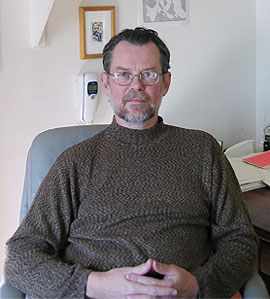
“What determines the success of a book is the book and the energy invested in it by the author and the publisher together.”
(Photo: Stephen Roxburgh)
Carolyn Coman, author of Newbery Honor book What Jamie Saw, has worked with Roxburgh to publish traditionally through Front Street Books and now at his new home, namelos, a decidedly non-traditional publisher. “Format has no effect whatsoever on our editorial discussions or process,” she says. “It has always been—and continues to be—about making the best book we can.”
Yet, format does affect readership. Turquoise Morning Press founder, Kim Jacobs, says distribution to online retailers is a huge part of her marketing plan, and if she were pressed to choose, she’d go with digital publishing over print publishing. “The books have to be out there in order for readers to buy them,” she says. Jacobs (whose own work appears under the pen name Maddie James) learned the importance of accessibility first hand when some of her earlier titles were backlisted by publishers. Jacobs claims, “As an author, when I look at my royalty statements each quarter, the evidence is clear that my digital books far outsell my paperback books.” While re-releasing those books might have been the impetus for starting Turquoise Morning Press, the company has grown into a successful small press employing an editorial staff to work with authors in multiple genres.
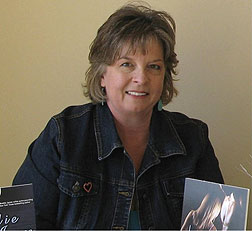
“As an author, when I look at my royalty statements each quarter, the evidence is clear that my digital books far outsell my paperback books.”
(Photo: Kim Jacobs, a.k.a. Maddie James)
Not everyone is equipped to start her own publishing company. Many emerging authors do, however, consider self-publishing their work as e-books. Author Laurie Dalzell (whose dark erotica appears under the pen name Annie Duvall) strongly cautions against that. “If a piece keeps bringing back rejections from traditional publishers, and you’re considering e-publishing independently with the idea that you can do this as easily as a small house—don’t.”
Coman says before getting caught up in the quest for publication, a writer should “write the best story she possibly can. Without a terrific manuscript, consideration of other things like marketing, format, and money is a waste of time. With a terrific manuscript in hand, possibilities arise.”
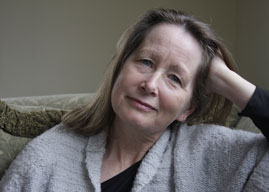
“Without a terrific manuscript, consideration of other things like marketing, format, and money is a waste of time.”
(Photo: Carolyn Coman)
Possibilities may include e-publishing. According to a report by Bowker, the main source of bibliographic data for the publishing industry, in 2009, the number of new titles published via non-traditional routes was more than double those published traditionally. E-publishing affords emerging writers more opportunities to get noticed. “E-publishing can allow previously unpublished authors a better chance to get in the door,” suggests Julie Fletcher, publisher of Black Label Books. “Most e-publishers do not require that an author have an agent and are more open [than traditional publishers] to manuscripts that would otherwise end up in the slush pile.”
Part of the reason e-publishers may be willing to consider writers that have been overlooked by traditional publishers is because of differing profit models. As Roxburgh explains, all editors must consider whether a book meets the minimal requirement for successful publication. He says, in today’s publishing environment, that is determined by asking not just if the book is good enough, but whether it will make money. Smaller presses generally have lower overhead, allowing them to invest in books that may sell fewer copies. Roxburgh suggests when submitting, an author look for a publisher that “provides the optimum combination of editorial guidance, marketing support, and balanced distribution of all formats of her book.”
Roxburgh’s statement gets right to the heart of why so many writers feel overwhelmed by the sheer number of companies throwing their hats in the publishing ring. How is a writer to determine which publisher offers that optimum combination?
“One size does not fit all,” cautions Nancy Naigle, whose most recent work, Out of Focus, will be released later this year by Turquoise Morning Press. She advises writers to set clear and measurable goals and weigh options by whether they provide momentum toward those goals. “I guess my advice is to give yourself time to make a good decision. It’s okay to say no if it doesn’t feel right. Be sure that the publisher’s goals align with your own. At the end of the day, this is your dream—give it the priority it deserves.” Jacobs agrees but recommends that a writer also look at the bigger picture. “The author needs to have a career plan—if she doesn’t, she should explore this more deeply before putting herself out there in any publishing house.”
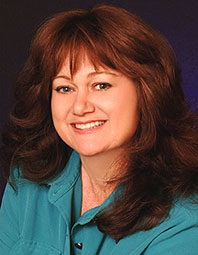
“Be sure that the publisher’s goals align with your own. At the end of the day, this is your dream—give it the priority it deserves.”
(Photo: Nancy Naigle)
An author’s career plan may be determined by multiple factors. “There are times when authors would find that e-publishing indie labels are best, if they have a great story that a bigger house refused, or they’re just starting out and want to test the waters of e-publishing,” Fletcher states.
Roxburgh adds that because most small presses publish e-books and make print formats available via print-on-demand technology, readers won’t see these titles stacked up in bookstores. He suggests, “If you’ve got a potboiler summer read that you think many people will buy on impulse or a brand name author who everybody wants immediately, you want stacks of your books in bookstores, where people will see them and grab them. For niche titles, books that people look for because they are interested in the subject or author, or books that sell primarily to libraries (e.g., hardcover juvenile fiction), you don’t care so much about stacks in stores because they wouldn’t sell there, and print on demand is a much more viable alternative.”
A few years ago the phrase “print on demand” may have conjured images of cut and paste cover art and low grade paper. Advances in technology have allowed even do-it-yourselfers to produce print books that look professionally done. But readers are discerning. They may take a chance on an unknown author; but if the story is poorly written or the formatting is wonky, they are unlikely to buy a second book by that author. Historical romance author Renee Vincent suggests that writers consider the quality of editing a publisher offers by reading a few books from that publisher. “If it seems like they’re producing anything with a beginning and an ending, then perhaps you should take heed.”
Roxburgh contends that “the publisher provides a level of curatorship, and e-books coming from known publishers will adhere to their quality standards.”
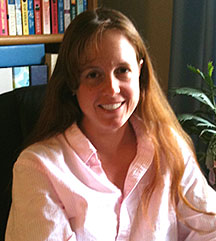
“My editor took the time to help me hone my creative talents, while encouraging me to work on my weaknesses.”
(Photo: Laurie Dalzell)
The publisher’s list certainly provides a glimpse into a company’s standards; but to really gauge quality, writers tend to look at the guidance and support offered during the editorial process. Jacobs says her company doesn’t distinguish between e-books and trade paperback books in terms of editing. As an author with Turquoise Morning Press, Vincent appreciates what she describes as a close-knit author-editor relationship. “Even though I may have always been a competent storyteller with a knack for twisting plots and creating in-depth characters, there were many things my prose lacked. My editor took the time to help me hone my creative talents, while encouraging me to work on my weaknesses.”
As both a publisher and a writer, Dalzell has particular insight into the editing process. She compares it to cleaning a teenager’s room. “He’s happy to agree that the dirty dishes are good to have gone, but he’s not so happy his stuff has been moved. Just like that teenager, that first glance through the critiques often has me spluttering. After the first read, I put it away for a day or so. When I’ve had time to consider what my editor has said, I can take it out again and look at her comments and suggestions a bit more objectively. Sometimes, the dirty socks go back under the bed, but more often not.”
Naigle notes that “because the time lines are generally tighter [with e-publishing], the editing process is compressed.” She counsels writers to “be ready to dig in and take action quickly when you get your edits, or you’ll find yourself taking shortcuts; and that’s never a good idea.”
Vincent reminds us that paying special attention to a publisher’s specifications can streamline the editorial process. “Uploading an e-book format is completely different from a print format, and it can become a hassle for the publisher if you didn’t follow their submission guidelines. Remember, those guidelines are there for a reason, and not every publisher’s specs are the same.”
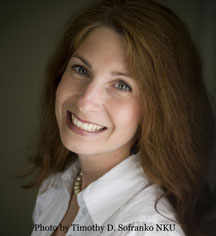
“Uploading an e-book format is completely different from a print format, and it can become a hassle for the publisher if you didn’t follow their submission guidelines.”
(Photo of Renee Vincent by Timothy D. Sofranko NKU)
Differences in small presses are not limited to their publication specs. Roxburgh defines his company, namelos, as “the opening move in a new age of publishing.” What distinguishes namelos is that in addition to publishing high quality literature for children and young adults, they also offer independent editorial services for writers wishing to submit elsewhere. Roxburgh says that simplifies the relationship between the author and the editor. “We have one job to do and that is help the author make the book the best she can make it. We don't have to be the in-house advocate for the book, nor do we have to ‘manage’ the author's relationship with the publishing house, nor do we have to ‘handle’ the author's hopes, dreams, and aspirations in regards to money and glory. Our focus is entirely on the quality of the book itself.”
Hard to argue with that. Isn’t that what we all want—a high quality book? I took all this information back to my pen and paper writer friends, sure that they would agree that there is really no difference between e-publishing and traditional publishing. Yet, after I made my case, the most stubborn among them politely smiled and asked, “So, how do you do a book tour or signing with only an e-book?” Luckily, I was ready for that one. Websites, blogs, and social media give us endless possibilities for author/audience interaction. I shared the sneak peek Naigle gave me into what she’s planning. “I’ve been toying with the idea of short lead-in stories that tie to the small town of Adams Grove that I’m writing about in my novels. I think short stories in e-format would be a fun connection, and the minor characters from my novels could get their stories told and keep readers excited while they wait for the next book.”
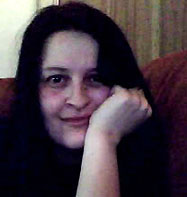
“Fletcher says she thinks virtual book signings will become the new ‘norm’...”
(Photo: Julie Fletcher)
Fletcher says she thinks virtual book signings will “become the new ‘norm’, with authors conducting live video chats, inserting signature graphics into their e-books, and having a virtual face-to-face.”
Roxburgh concurs. “Lots of very clever people are coming up with even more clever ways to personalize books—some of them are quite remarkable—including being able to take a picture (of the author with the customer), having the author autograph the photo, and embedding it in the e-book.”
Even my friendly skeptic looked excited at that idea. “Now, if they can just think of a way to inject e-readers with that musky library smell,” she said. I was ready for that one, too. The look on her face was well worth the $12 bottle of In the Library from Christopher Brosius’s I Hate Perfume collection.
***
Katherine Higgs-Coulthard is founder and director of Michiana Writers’ Center in Indiana, a fun job that provides just enough income to support her addictions: caramel macchioatos and frenzied bursts of caffeinated fiction writing. Kathy’s YA novel is in its umpteenth revision and soon will be making its way to NYC and into the hands of eager editors (who may or may not be figments of Kathy’s imagination).
Enjoyed this article? Check out more from Katherine on WOW!:
How to Trim the Fat from Your Manuscript
Channeling the Voice of Youth: An Interview with Ellen Hopkins
How to Start a Writers’ Group in Your Area (featuring Katherine Higgs-Coulthard)
Related article:
Getting the Skinny on e-Publishing: Top e-Publishers Tell Us What You Need to Know - Interviews with Victor R. Volkman (Loving, Healing Press), Cheryl Kaye Tardif (Imajin Press), Stephanie Taylor (Astraea Press), Barbara Rollins (Eagle Wings Press), and Nancy Shumacher (Melange Press).
20 Questions Answered By 5 Professionals: The Future of Digital Publishing